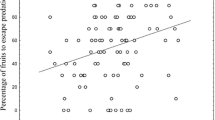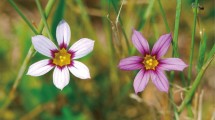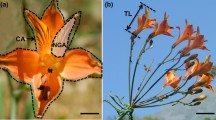Abstract
Evolutionary biologists continue to disagree about the relative importance of natural selection, drift and phylogenetic constraint in determining characteristics of an organism1. Because of the difficulty of identifying examples of selection in nature there are few rigorous field studies of selection2–6. We have been studying selection on flower colour in the small perennial larkspur Delphinium nelsonii, a native to mountains of the western USA. Previously we showed that white-flowered forms, which are very rare in natural populations, produce fewer seeds than their common blue-flowered conspecifics, and that this selective disadvantage results from partial discrimination against white flowers by bumblebee and hummingbird pollinators7. Here we present evidence that discrimination occurs because white flowers have inferior ‘nectar guides’ and therefore require longer handling times than blue flowers. Pollinators may thus experience lower net rates of energy intake on white flowers, a sufficient reason for undervisitation by optimally-foraging animals.
Similar content being viewed by others
References
Gould, S. J. & Lewontin, R. C. Proc. R. Soc. B205, 581–598 (1979).
Camin, J. H. & Ehrlich, P. R. Evolution 12, 504–511 (1958).
Kettlewell, H. B. D. Heredity 10, 287–301 (1956).
Boag, P. T. & Grant, P. R. Science 214, 82–85 (1981).
McNeilly, T. & Bradshaw, A. D. Evolution 22, 108–118 (1968).
Cain, A. J. & Sheppard, P. M. Genetics 39, 89–116 (1954).
Waser, N. M. & Price, M. V. Evolution 35, 376–390 (1981).
Pyke, G. H., Pulliam, H. R. & Charnov, E. L. Q. Rev. Biol. 52, 137–154 (1977).
Pyke, G. H. in Foraging Behavior: Ecological, Ethological, and Pyscological Approaches (eds Kamil, A. C. & Sargent, T.) 19–38 (Garland, New York, 1981).
Pleasants, J. M. Ecology 62, 1648–1661 (1981).
Fretwell, S. D. & Lucas, H. L. Acta Biotheor. 19, 16–36 (1969).
Menzel, R., Erber, J. & Masuhr, T. in Experimental Analysis of Insect Behavior (ed. Browne, L. B.) 195–217 (Springer, New York, 1974).
Goldsmith, T. H. & Goldsmith, K. M. J. comp. Physiol. 130, 209–220 (1979).
Laverty, T. M. Can. J. Zool. 58, 1324–1335 (1980).
Kay, Q. O. N., Daoud, H. S. & Stirton, C. H. Bot. J. Linn. Soc. 83, 57–84 (1981).
Kevan, P. Canad. J. Bot. 50, 2289–2316 (1972).
Goldsmith, T. H. & Bernard, G. D. in The Physiology of Insects (ed. Rockstein, M.) 166–270 (Academic, New York, 1974).
Goldsmith, T. H. Science 207, 786–788 (1980).
Sprengel, C. K. Das Entdeckte Geheimniss der Natur im Bau und in der Befruchtung der Blumen (Vieweg, Berlin, 1973).
Waser, N. M. in Pollination Ecology (ed. Real, L. A.) (Academic, New York, in the press).
Author information
Authors and Affiliations
Rights and permissions
About this article
Cite this article
Waser, N., Price, M. Pollinator behaviour and natural selection for flower colour in Delphinium nelsonii. Nature 302, 422–424 (1983). https://doi.org/10.1038/302422a0
Received:
Accepted:
Issue Date:
DOI: https://doi.org/10.1038/302422a0
- Springer Nature Limited
This article is cited by
-
Electric field detection as floral cue in hoverfly pollination
Scientific Reports (2021)
-
Increased Insect Pollinator Service Overcomes Barriers in Reproductive Success of Aesculus indica Colebr. (Hippocastanaceae) in the Temperate Himalaya
Proceedings of the Zoological Society (2021)
-
Intraspecific floral color variation as perceived by pollinators and non-pollinators: evidence for pollinator-imposed constraints?
Evolutionary Ecology (2019)
-
Fine mapping and candidate gene analysis of the yellow petal gene ckpc in Chinese kale (Brassica oleracea L. var. alboglabra Bailey) by whole-genome resequencing
Molecular Breeding (2019)
-
Understanding the impact of plant–arthropod interactions, pollination, and canopy light on the rare orchid, small whorled pogonia (Isotria medeoloides)
Plant Ecology (2019)





